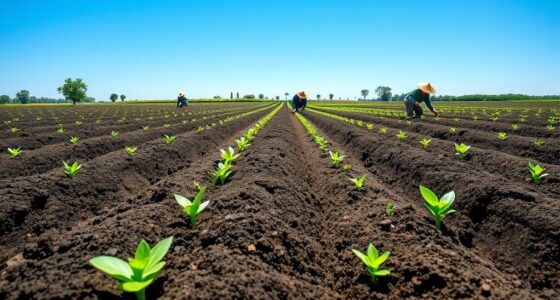To estimate your cord yield per acre, start by evaluating tree density and species-specific wood density, which impacts volume and energy content. Measure or estimate the number of trees per acre, considering their size and growth stage. Use average wood density data to convert volume into weight or energy potential. Harvest timing also plays a role in quality and yield. Keep these factors in mind, and you’ll be better equipped to gauge your sustainable timber or firewood production as you explore further.
Key Takeaways
- Measure or estimate the average tree volume per acre, considering stand density and tree size.
- Determine the species-specific wood density to convert volume into weight or usable wood.
- Calculate total volume by multiplying average tree volume by the number of trees per acre.
- Convert total volume to cords using standard conversion factors, accounting for moisture content.
- Adjust estimates based on harvest timing and wood density to improve accuracy of cord yield per acre.

Estimating cord yield per acre is vital for anyone involved in timber management or firewood production. Knowing how much wood you can expect from a given area helps you plan your operations more effectively, whether you’re selling firewood or managing a forest for long-term sustainability. To do this accurately, you need to consider factors like wood density and harvest timing, as they directly influence how much usable wood you’ll gather from each acre.
Wood density plays a fundamental role in estimating cord yield because it determines the weight and volume of the wood you can expect. Denser woods, like oak or hickory, pack more weight and occupy less space for the same volume compared to softer woods like pine or poplar. When estimating cords, you should use average wood densities for the species you’re working with. This helps convert your measurements—like volume or count of logs—into more standardized units. The higher the wood density, the more energy or heat you’ll get from each cord, making your estimates more precise and useful for pricing or planning purposes.
Wood density determines volume, weight, and energy content, vital for accurate cord yield estimates.
Harvest timing is another essential factor. The right timing ensures you maximize both yield and quality. For example, harvesting in late winter or early spring, when trees are dormant, often results in cleaner cuts and less damage to the remaining stand, which can promote faster regrowth. Additionally, harvesting at the ideal time prevents wood from becoming overly moist or decayed, which can reduce the actual usable volume and weight. If you harvest too early, you risk dealing with wood that’s still too wet, leading to lower firewood efficiency and potential storage issues. Waiting too long might mean trees are more prone to pests or disease, which can diminish the quality and volume of your harvest. Using keto diet tracking apps or online tools can help monitor these variables more accurately.
Frequently Asked Questions
What Tools Are Best for Measuring Forest Density?
You should use measurement tools like a relascope or prism prism to gauge forest density accurately. These tools help you determine tree spacing and basal area, which are key indicators of forest density. A laser rangefinder can also be useful for measuring tree height and stand volume. Combining these tools provides a thorough view of forest density, enabling you to make informed decisions about forest management and timber yield estimates.
How Does Tree Species Affect Cord Yield?
Tree species substantially influence cord yield because of species variation and growth rate. Faster-growing species typically produce more wood, increasing your yield per acre. Hardwoods like oak or maple often yield more cord volume than slower-growing softwoods. By understanding these differences, you can better estimate your potential cord yield. Selecting high-growth-rate species suited to your land also helps maximize your harvest, making your forestry efforts more efficient and profitable.
Can Remote Sensing Improve Yield Estimates?
Think of remote sensing as a bird’s eye view that boosts your yield prediction accuracy. It captures detailed data on forest conditions, helping you estimate cord yield per acre more precisely. I saw a forestry team improve their estimates by 20% using satellite imagery, making planning smarter. Remote sensing provides timely, consistent information, allowing you to monitor growth trends and enhance your yield prediction efforts effectively.
What Are Common Errors in Estimating Cord Yield?
You often encounter errors like sample bias, which skews your yield estimates if your samples aren’t representative. Measurement precision also matters; small inconsistencies in measuring tree volume or wood density can lead to significant errors. To improve accuracy, make sure your sampling covers diverse areas and use precise tools. Being aware of these common errors helps you refine your methods, leading to more reliable cord yield estimates per acre.
How Does Weather Impact Wood Growth and Yield?
Weather patterns act like a puppeteer pulling the strings of wood growth and yield. When drought effects strike, trees struggle to absorb nutrients, stunting their growth and reducing cord yield per acre. Excessive rainfall can also hinder growth by causing root rot or delaying harvesting. You need to monitor these weather influences closely, as they directly impact the health of your stand and your overall timber production.
Conclusion
Now that you understand how to estimate cord yield per acre, think of your forest as a treasure chest waiting to be opened. With each measurement and calculation, you’re turning the key to reveal the valuable wood inside. By carefully estimating, you’re like a skilled painter adding vibrant strokes to a masterpiece. When you combine your knowledge and effort, you’ll unlock the full potential of your land, turning your forest into a bountiful harvest ready to be enjoyed.








